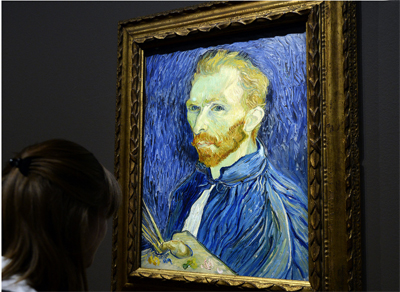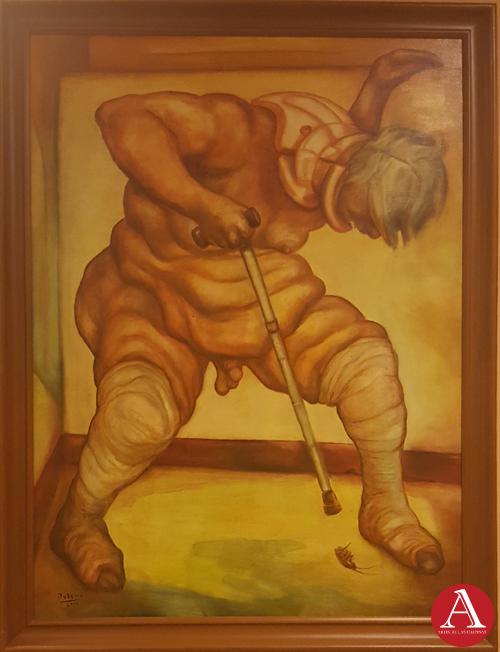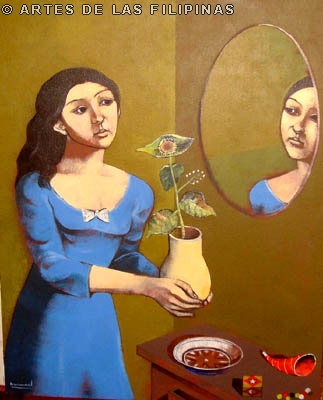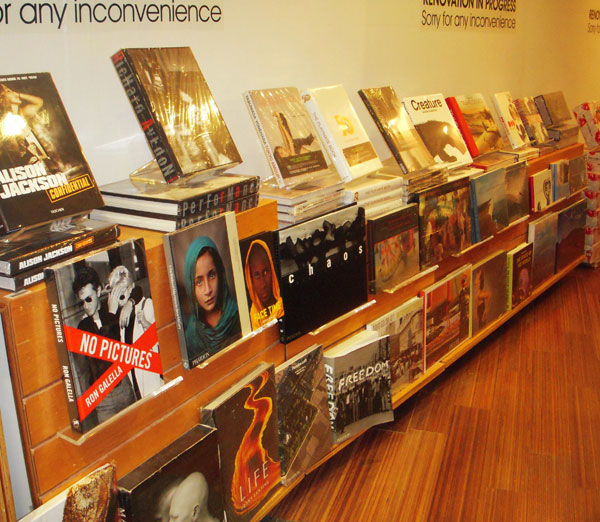
FILIPINO ART COLLECTOR: ALEXANDER S. NARCISO
by: Christiane L. de la Paz
March 2024 – Alexander Narciso is a Philosophy graduate from the Ateneo de Manila University, a master’s degree holder in Industry Economics from the Center for Research and Communication and a fellow with distinction of the Life Management Institute. He started his profession as a career agent in Sun Life in 1986 before moving to the head office in 1989, in charge of various agency support roles that include sales training and promotions and agency events. He then took the role of Director for Marketing, Chief Agency Distribution Officer and eventually was appointed the President of Sun Life of Canada Philippines, Incorporated. He retired from this post in December 2023 but remains as the President of Sun Life Foundation.
In 1993, Narciso bought three paintings by Angelito Balagtas, Harlem Barilea and Romy Gutierrez that jumpstarted his peregrination to art collecting. In a period of a little over three decades, his art collection now comprised of the works of the Masters, modern artists who launched their careers in the 1960s to 1990s as well as contemporary artists whose works embrace multiple voices and perspectives and reflect the scale and ambition of contemporary practices. Significant movements are also well-accounted for including realism, hyperrealism, impressionism, surrealism, pop and abstract expressionism, emphasizing pieces with fascinating anecdotal interest. In the process of his collecting activities, he put forward his view that art collecting is a marker of class, refinement, erudition and a stamp of “having arrived.” From purchasing art pieces that evoke emotion to gaining an enlightened taste, Narciso has explored the various dimensions that a well-handled art collection can serve as a beautiful example of how an asset can fit into a portfolio and support a patron’s long-term goals.

Three Generations
Lito Balagtas
1992
At what age did you buy your first artwork?
I bought three paintings in 1993 at the age of thirty-four. The first is a watercolor painting of a boy fishing with his dog by Domy Gutierrez. As a boy, I always imagined how fun it was to be outdoors in the field or fishing especially if accompanied by your dog. The second is a pastel still life painting of mangoes in a bushel by Harlem Barilea. I was very impressed with the level of detail that he rendered in the basket weave. The third art piece was a gouache on paper of a family of three generations by Angelito Balagtas that showcased his style of cubism inspired by Vicente Manansala. I also like the colors and figures of the family vending goods on the sidewalk. I don’t know for sure but this may be derived from an original Vicente Manansala painting. These three paintings are still with me but unfortunately have not met any of the three artists nor attended any of their exhibitions.

Mangoes in a Basket
Harlem Barilea
1992
Did you purchase art objects abruptly or moderately when you moved into your first house?
The three paintings I bought happened when we moved to our town house in Parañaque after getting married. These three paintings were unplanned. I visited a gallery inside BF Homes and met the owner, a woman in her thirties, who showed me around and made recommendations. I was impressed with her knowledge of art. The three paintings I bought enhanced our little abode and on several lazy weekends, I even found myself staring and appreciating these works.

Red Kois
Ricky Montilla
2015
Who decides what art objects to collect?
I consult my wife and daughter once in a while but I alone decide the artworks to buy. Sometimes they would send me photos of artworks for sale that they see and think are nice for me to consider. My wife dislikes art pieces that are sad but I, on the other hand, like such pieces so I ended up buying them. I do not display them in our house but are housed in a rented storage.

Sheer Fabrics and Metals IV
Alfred Galura
2018
What was your early exposure to art?
My early exposure to art was reading history books and I came to know Juan Luna, some European masters by seeing pictures of their works. I never went to any gallery or museum when I was young nor was there art in the house where I grew up.

Serenading the Light
Andoi Solon
2010
What did you collect as a child?
I collected stamps in high school but they were ordinary; nothing special or rare, really. This small stamp collection of mine was damaged over time as our house was regularly flooded. After that, I bought a lot of books on business such as In Search of Excellence and From Good to Great; life stages and living a life such as the Passages, 7 Habits of Highly Effective People; and books on leadership and management including Measure What Matters and Leadership Challenge. I also read up on history, global trends and politics and valued the insights from the Books That Changed the World and A Question of Heroes. I enjoy mostly the works of Malcolm Gladwell, Daniel Pink and Heath Brothers. All these books, I hope to read again as I have more time now having recently retired.

Paper Boats: A Perfect Day with my Dad
Michael Cacnio
2016
What do you consider your first important art piece?
A couple of sculptures which I bought at the same time. One was a piece of a boy flying a kite by Michael Cacnio and the other one was a glass sculpture by Ramon Orlina.

Bushels of Corn
Prudencio Lamarrozza
1999
What followed?
Manuel Baldemor and Lydia Velasco’s works. The sales representative of the gallery that dealt directly with Baldemor and Velasco offered the works to me at a good price. Then I met an art dealer who sourced works by Federico Alcuaz. And since Alcuaz was a National Artist, I was easily convinced to purchase his works one at the other. I even redeemed from my mutual funds to pay for some of these purchases! In hindsight, I should have been more judicious in purchasing the works of Federico Alcuaz, Manny Baldemor and Lydia Velasco. From an investment perspective, the prices of their works have not increased much from the time I bought them. I think I would be better off buying additional works by Ramon Orlina and Michael Cacnio whose prices have increased significantly.

Amburayan Dream
Prudencio Lamarrozza
2011
The works of Glenn Bautista and Prudencio Lamarroza are well-represented in your art collection. Tell me about this.
I learned from the son of a gallery owner that in the early 1980s to 1990s their gallery had a stable of artists and was known for promoting talented and upcoming artists. Two of their artists were Glenn Bautista and Prudencio Lamarroza and the gallery has a good number of their works in their collection. Mind you these works were painted by artists at their prime. I was able to buy several of these pieces, some of which were even book pieces. A couple of years later, I met a freelance art dealer who had access to Lamarroza and his manager. This dealer was able to get pieces from the artist’s collection which was then offered to me.

Big Nude
Mario Panis
2000
What is your favorite piece in your collection?
The Big Nude by Mario Panis. I bought this directly from the artist. He said that the subject was a famous band singer in the 1990s to early 2000s. It was commissioned but the one who commissioned this work reneged and so the artist kept the piece. I fell in love with this piece the first time I saw it. I simply love the pose, the body contour and the mystery that the image evokes. I find her lying position so natural. I even imagined that she might have fallen asleep while posing or tired from a gig the night before. Her face is not visible either so I can’t say if she is pretty or not but I like it this way so it doesn’t distract. This also adds to the realism of the piece in which nothing is glamorized unlike the usual photos you see in fashion magazines.

The Wanderer
Orly Ypon
2013
Any other picks?
I like The Wanderer by Orly Ypon for several reasons. I like the subject of being alone, of being lost. The piece triggers contemplation, narration and imagination of the girl in the composition. What kind of girl is she? How did she end up here? Is she lost? Are her parents looking for her? What is the message, if any, of the artist? I like art pieces that trigger a reaction, a feeling or make you imagine a narrative. I also like the contrast posed by the girl with a white hat and red dress versus her surroundings which are mostly green and brown. The trees and the surroundings are well-painted. Somehow, this piece reminds me of my only daughter.

Port of Departure
Roland Laureano
2018
The painting, Point of Departure 1 by Roland Laureano is another piece that I like. I have always thought that an artwork must show a living subject like a cat, a dog or a person for it to elicit an emotion from the viewer. I was surprised that this work of Llarena which has no living subject was able to make me feel so many emotions. The subject is an ordinary maleta left outside the gate of a lower-middle-class house, parked outside, ready to go but with no owner in sight. This painting triggered in me a story of separation, abuse, loneliness, love and sacrifice. Si Tatay ba ang aalis? Si Nanay? Si Kuya? Si Ate?

I Will Sleep With You Tonight
Rene Cuvos
2019
I also have this commissioned piece, I Will Stay With You Tonight by Rene Cuvos, who is known for creating whimsical characters and scenes. I asked him to draw the characters in the world he has created including the human who is taking care of them. This piece speaks of the comfort and assurance that one receives from a loved one, something we all need, especially a child, when monsters and nightmares come at night. Funny but even without knowing the title of this piece, I could feel the comfort and assurance the whimsical characters are feeling simply because the girl will be staying with them.

Act Justly, Love Mercy, Walk Humbly
Jaime Gubaton
2017
Act Justly, Love Mercy, Walk Humbly by Jaime Gubaton also provokes to see a thought. A Jesuit dictum, “to see God in all things,” makes me realize that God is not only seen in extraordinary things but also in the ordinary. And what could be more ordinary than a traffic light? When Jaime and Jaqui delivered this piece and contemplated on it, I could not help but think that God speaks to us through whispers and the ordinary things we experience every day.

Haze and Mist You Must Face
Joie Pabilando
2019
I bought from Joie Pabilando the painting, Haze and Mist You Must Face. This painting triggers a feeling and one can’t help but imagine all sorts of narrative about the scene being depicted and even from the perspective of the different characters in the scene. He depicted this scene as if you are sitting in your car watching an ordinary scene through your windshield. The scene reminded me of the Beatles’ iconic cover photo, Abbey Road, for their final album in 1969. There is, however, nothing iconic in this painting. It’s just a scene of ordinary people walking, probably crossing the street and going about their daily lives amidst the rain. Galeng! This painting triggers all sorts of narrative about what is going in the lives of these people. It also happens that I do love it when it rains! I bought several pieces of ordinary scenes on a rainy day from Joie. I really admire his use of watercolor in capturing these scenes. Joie also joined an international contest for watercolor and ended up winning the grand prize. This made me realize that ordinary scenes on a rainy day have an international appeal.

Sleeping Man (Tribute to Caravaggio)
Orly Ypon
2019
Who was the first Filipino artist whom you came to know?
Through history books, I learned about Juan Luna. I love his Spolarium! It is a big and well-composed piece that captures the scene after a vicious fight of gladiators in the Arena. Viewing this piece, one can’t help but react to the different scenes in the piece and imagine all sorts of stories and feelings of the characters. The Spolarium is a kind of work you simply cannot react to! You won’t be able to just pass it!

Patmos
Glenn Bautista
1995
Any other Filipino artists whom you considered great?
I like the works of cubism of Vicente Manansala and Cesar Legaspi and the minimalism of Fernando Zobel. I have read about them together with other Filipino artists such as Federico Aguilar Alcuaz, Manuel Baldemor, Glenn Bautista, Amor Lamarroza, Juvenal Sanso, Jerry Navarro and Edwin Wilwayco, among others. I also read up on the history of Philippine art especially the break of the thirteen modern artists which gave birth to Philippine modern art. This is my way of following the advice of learning as much about art and artists.

Composition
Federico Aguilar Alcuaz
1974
What about works by foreign artists?
Although I have been collecting more of the works of Filipino artists, I have, in recent years, started buying the works of foreign artists like Hae Ryun from Korea, Hideo Tanaka from Japan, Roby Dwi Antono from Indonesia and Martha Hildebrand from Canada.

Composition
Federico Aguilar Alcuaz
1983
What museum pieces would you like to own?
If I have a mansion and the size of the museum piece will not be a concern I want to own Juan Luna’s Spolarium, Rembrandt’s Night Watch, Caravaggio’s Dinner at Emmaus and Doubting Thomas. I like these works because they are dramatic. I also like Leonardo da Vinci’s The Last Supper and Mona Lisa. They are worth studying because of the perfection of the technique in which they rendered these works.

Daniel de la Cruz
How can I explain this feeling
2018
What do you enjoy about collecting art?
I once read that to be considered rich you have to know how to appreciate and own an art collection. Collecting art indicates class, refinement and the idea of “having arrived.” Some people buy and wear a Rolex watch to let the world know of their success but I don’t fancy watches. I prefer to collect art to show that I, too, “have arrived.” This was one of the reasons why I bought my first Ramon Orlina glass sculpture. Secondly, I like things of beauty – those that you don’t get tired of looking at. Unfortunately, I have picked some works that I liked at the time I bought them but which I eventually outgrew. It is not easy unloading art pieces which is why I am wary of the advice that you buy works that you like.
I also consider art as an investment. Picking works of upcoming artists is a sort of game for me on whether I can spot the next Vicente Manansala or Jose Joya. Even if nagsawa ako but if the price of the piece is steadily increasing then I am okay with it.

Collecting art is also an intellectual stimulation for me. It triggers feelings, questions, reactions and narratives. It’s like having a conversation with the piece of art or the artist who made it. This is the reason why when I buy a piece, I ask the artist to write a statement that explains the story or inspiration of his piece. What is the piece about?

Composition 118 Whispers
Rodolfo Gan
2018
Collecting art is also my simple way of supporting local art and local artists, especially the upcoming ones. Thus, one of my dream projects is to identify a handful of artists who I consider talented and provide them with a means to develop their craft. I don’t know how to execute this at this time but if I will put up an exhibition for them, I am willing to just break even in the first few exhibitions while the artists are getting a name for themselves and establishing their identities.

Aside from the sheer enjoyment of looking at beautiful artworks, I think that art collecting is also a good way to grow your funds. The reason for this is because artworks appreciate. As an artist gains prominence and the demand for his works increases, the price of his works also increases.
Lastly, one has to contend with one’s attachment to the piece, making it difficult to let go and sell the piece. Another thing of course is the difficulty of selling artworks even at their current market price. Selling them via auction houses is an option but with the huge cut the auction house takes, chances are, you will end up getting an amount much lower than the market price or even your purchase price!

Sarimanok
Abdulmari Imao
2009
Why should beginners understand art collection as an investment opportunity?
One of the advice about art collecting that I was given and which one hears often is to “buy only artworks that you like.” The problem with this advice is that there are simply so many artworks that appeal to you. One of the ways to narrow the options is to consider which among these art pieces you like offer better chances of appreciating significantly especially in the next five to ten years. Worse case, if your expectations don’t pan out, for example, the price of the piece that you bought doesn’t increase as significantly as you expected, you will still end up with the piece that you like! This is different from just buying a piece simply for investment purposes or the name of the artist even if you really don’t like the piece!

Yellow Landscape
Raul Isidro
2013
What is your long-term plan for your art collection?
Now that I am retired, I will already start selling off my art pieces and continue to do so throughout my retirement years. I expect that in the end, I will be left with about 10% of what I have now. I will then bequeath this humble art collection to my only daughter with a request that she consider donating this collection to a school in my name with a requirement that the school exhibit this collection at least twice a year. This is my simple way of inspiring future generations to appreciate and support the works of our local artists. I am also hoping that the school will not only exhibit the artworks but will also display the write-ups accompanying the pieces wherein I tried to capture the feelings, thoughts and insights triggered by the piece. My aim in doing this is to encourage young viewers to consider doing their own art collecting in the future, seeing that even if your art collection is composed of simple works, not necessarily the Masters, the art collection can still be a source of enjoyment, contemplation, conversation, and even investment returns, and, therefore worth doing.












